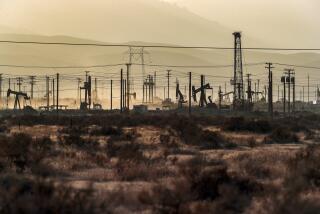Seeking to bury the CO2 problem
- Share via
DECATUR, ILL. — The drillers have gnawed through a mile of rock here, almost down to a 600-million-year-old layer of sandstone where they hope to bury about 1 million metric tons of carbon dioxide -- equal to the annual emissions of 220,000 automobiles.
The $84-million project, of which $66.7 million comes from the Energy Department, will help determine whether storing greenhouse gases underground, so-called sequestration, is a viable solution for global warming.
The project by Archer Daniels Midland Co., in which greenhouses gases from a corn mill will be buried beneath shale, is important because it’s the furthest along of the seven federally sponsored partnerships nationwide to study the matter.
Near the drilling derrick are steel drill bits caked with mud and worn to nubs. Drillers have already burrowed 5,300 feet deep, and they have 2,700 feet left to go.
The idea is that by burying emissions, coal power plants and factories would cause less damage to the environment.
“The day has to come when we can remove coal from the ground and return carbon dioxide” to the ground, Sen. Richard J. Durbin (D-Ill.) said at the official groundbreaking Monday of ADM’s project.
Durbin has been a proponent of sequestration on Capitol Hill, having included $1 billion in the stimulus package to potentially restart FutureGen, an experimental coal power plant to be built in Mattoon, Ill., that would use sequestration. The Bush administration had pulled the plug on FutureGen.
Yet environmental groups say the government should not fund sequestration projects because of the risk of leaks.
“It is complete hubris to believe we can sink carbon dioxide into the ground and think there will be no leakage,” said Carroll Muffett, a Greenpeace deputy campaigns director. “We see carbon capture as a serious distraction from real solutions. It’s certainly not where public money should be going.”
A gushing leak not only could release the emissions back into the atmosphere, it might also pose health risks to people in the form of “immediate death from asphyxiation” or prolonged exposure to high amounts of carbon dioxide, said David Gerard, executive director of the Center for the Study and Improvement of Regulation at Carnegie Mellon University in Pittsburgh.
The major question is whether shale will stop the waste from escaping. Shale resembles a series of overlapping flat plates that contain no room for the gases to pass through; the shale is a rock layer just above the sandstone at the ADM site.
“Right now we’re evaluating the shale to make sure it will hold the carbon dioxide,” said Jared Walker, a supervisor on the site for Schlumberger Carbon Services.
“With carbon dioxide, it’s important that if we put it in the ground, it stays in the ground,” said Scott Marsteller, a project manager for Schlumberger Carbon Services. “We’re doing a lot of monitoring.”
Also at stake with the ADM project is whether similar geological formations around the country and world can be used for sequestration.
If storage cannot be duplicated on a widespread basis, “it’s not the option we’re going to pursue,” said Scott Klara, director of the Energy Department’s Strategic Center for Coal.
The key to sequestration is dealing with different types of rock beneath the Earth’s surface. Sandstone is porous, sort of like a box of marbles, explained Robert Finley, director of the Energy and Earth Resources Center of the Illinois State Geological Survey.
ADM plans to inject a liquid form of carbon dioxide waste from its mill into the space between the “marbles.” Beginning about a year from now, ADM would deposit 1,000 metric tons of emissions each day, shooting them about 8,000 feet into the ground.
The injections at the ADM project would stop in 2013 with about 1 million metric tons, at which point the partnership would continue to study the site for potential leaks.
--
More to Read
Sign up for Essential California
The most important California stories and recommendations in your inbox every morning.
You may occasionally receive promotional content from the Los Angeles Times.












